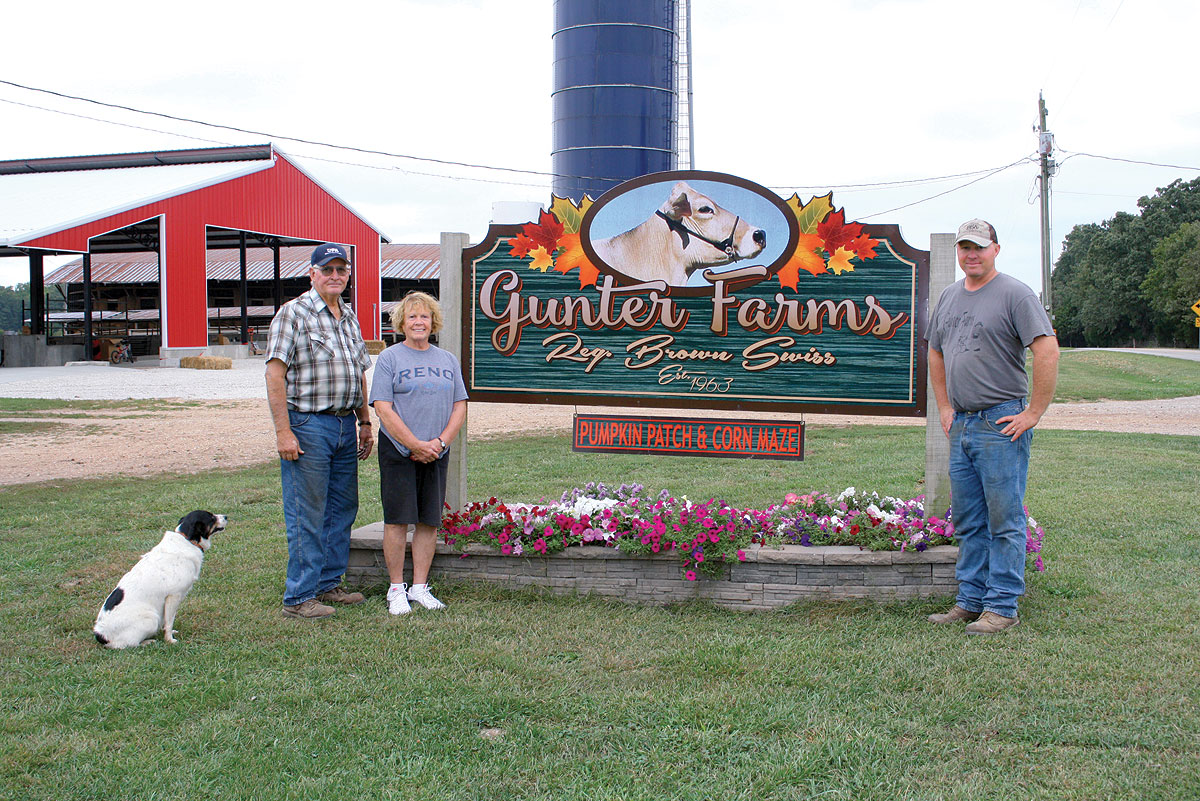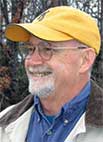
The Gunter family promotes the dairy industry and agriculture by offering a corn maze and pumpkin patch
Each October for the last 17 years, the Lloyd and Jane Gunter family has opened their farm to visitors for a little fall fun – and to educate them about the dairy industry.
Gunter Farms, located in rural Webster County, Mo., near Conway, has been in the dairy business since 1963 with registered Brown Swiss, as well as some Holsteins. Today, Lloyd and Jane, along with their youngest son David, his wife Courtney and their three children, handle the daily operation of the 365-acre farm. Other family members pitch in when needed, especially each weekend in October when Gunter’s Pumpkin Patch and Corn Maze is open.
On a typical October day at the Gunter farm, the family will explain what a dairy farm is, how much their cows and calves eat, how much the animals weigh, how farmers work to be good stewards of the land, and show guests exactly where milk comes from.
Yes, they have been asked if their cows give chocolate milk.
“That’s when I squirt the milk out at them and ask them what color it is,” Lloyd said.
Inside a barn, which serves as a machinery shed and shop until only a few days before the maze and pumpkin patch opens, there are hands-on games for kids, and adults, to play, such as a corn pit, apple basket toss and calf bottle bowling.
Jane, who is a retired teacher, also distributes age-appropriate books and agriculture information that children can take home.
“A lot of the kids get off the bus wanting to see the pigs, chickens and horses,” Jane said. “I explain that we’re a dairy farm, so we have cows, and that pig farmers have pigs and chicken farmers have chickens. It’s not like in the story books.”
Jane said adults often ask about antibiotics and hormones in milk.
“I ask them if they treat their sick children; they say yes,” Jane said. “I tell people “I’m going to treat my animals if they are sick, just like they treat their family members because these are my family. People ask about hormone-free milk. By nature, cows have hormones, we don’t add hormones, but if someone tells you milk is 100 percent free of hormones, there’s no such thing. People say they never thought about that.”
The corn maze is on 12 acres of the farm, and each year Lloyd cuts a new scene, using just his many years of experience running a combine, not GPS. This year’s maze depicts milk being poured from a bottle (complete with the letters M-I-L-K on the side), a heart, the letter U and 2017,
“Milk loves you, 2017,” Lloyd said.
The corn maze is not a “spooky” place for visitors. Throughout the maze are informational signs about agriculture and the Gunters explain that come November, the maze will be converted into feed for their cows.
“I tell people if they throw just one ear of corn on the ground, that is a bite of feed for the cows that’s wasted,” Lloyd said. “We try to let people know we utilize everything on the farm.”
The Gunters also plant about 5 to 6 acres of pie pumpkins, using their corn planter, annually. Each person who comes to the farm is welcome to take one of the pumpkins, or there are larger pumpkins available to purchase.
“We want families to spend time with their kids,” Lloyd said. “We want people to learn things.”
While Gunter Farms serves as agritourim destination from Oct. 1-31, it’s a full-time dairy farm; growing it’s own silage, alfalfa and hay. They also grow wheat and bale their own straw, which they sell at the farm for decoration, animal bedding or gardening.
The family recently completed an 86-foot by 200-foot compost bedded pack barn. The new edition to the farm will allow the Gunters to house and feed 100 cows, while creating compost that can be used to fertilize the farm’s fields and pastures.
“There’s a few in Missouri, but not many,” David said. “We spread the sawdust about a foot deep and at least once a day, we till it until the manure is back down in the pack and let that start composting. It will eventually get about 3 to 4 feet deep, and when it gets to a certain moisture level, you haul it out and it will be fertilizer.”
The compost, Lloyd explained, will help increase the organic matter of their pastures and fields, and increase soil fertility.
The facility, which features covered feeding alley, state-of-the art fans, automatic LED lighting, a flush cleaning system, three waterers (which can be easily dumped and cleaned), a back scratcher and a row of freestall stantions that will aid in animal health.
“All of the electric lights here can run on a single 10 amp breaker,” Lloyd said, which will be a tremendous cost savings for the farm’s electricity costs.
David added that having feed under cover will also help optimize usage.
“Right now, we’re putting their feed, which is corn silage and alfalfa, on the ground and I know we’re wasting half of it, at least,” he explained. “They aren’t going to waste feed with this, so we hope that will help pay for some of this too.”
Because it’s protected from the elements, any feed left over can be removed from the feeding area, remixed and fed to dry cows or heifers.
The barn will also increase cow comfort. By increasing cow comfort, the Gunters hope to increase each cow’s production level, maybe as much as 10 pounds per animal, per day.
“There’s 100-square foot for each cow, so that they aren’t cramped,” David explained. “A lot of people ask why we didn’t build a new milking parlor, instead of a barn. With this, the cows will help build our parlor. We take care of our cows before we take care of themselves.”
“We want to make sure we take care of our cattle, and we want to show people that we do take care of our cattle because they take care of us,” Lloyd said. “Our older barns were needing to come down and that’s another reason why we did this. Hopefully, in a few years, we can replace the dairy barn.”
Lloyd said they still may pasture their cows during certain times of the year.
“We want happy cows,” he said. “Happy cows give more milk.”
While some dairy producers are shuttering their milking parlors, the Gunters are looking for new ways to keep their family operation growing.
“I’m old-fashioned, but I’m not old-fashioned enough that I can’t give in to new technology,” Lloyd said. “It takes me a while to learn it, but we need to look at things to make our cows happy, content and give more milk. The end result is to have the cows giving more milk, which will make our life better. This is our livelihood, how we make our living.”
Lloyd and Jane give credit to David for their new facility, but the younger Gunter has more goals on the horizon for the farm.
“Robotic milkers,” David said with a smile.






